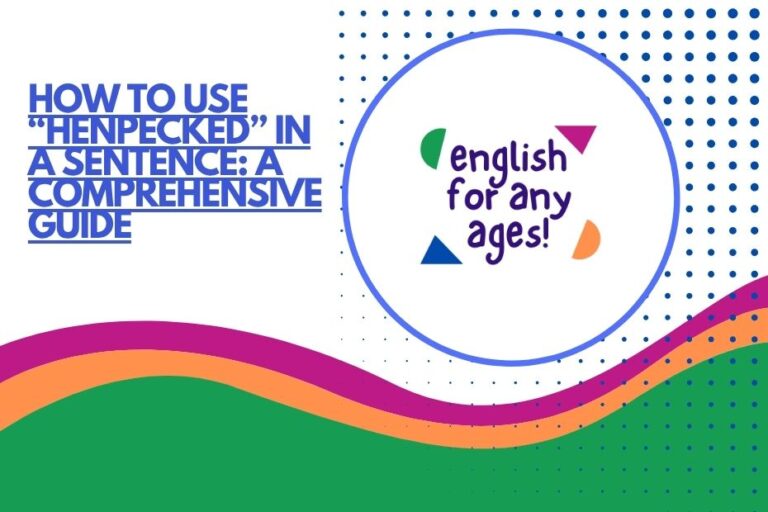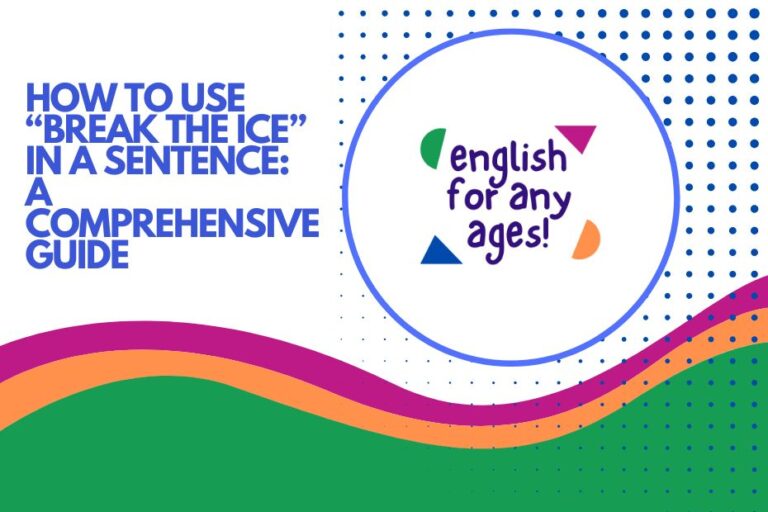Mastering “Underneath”: Sentence Examples and Usage
Understanding prepositions is crucial for constructing clear and grammatically correct sentences in English. Among these, “underneath” specifies a position directly below something, often implying concealment or support.
This article provides a comprehensive guide to using “underneath” effectively. It covers its definition, structural roles, different contexts, and common mistakes to avoid.
Moreover, this guide is designed for English language learners of all levels, from beginners to advanced speakers, aiming to enhance their understanding and application of this versatile preposition.
Table of Contents
- Introduction
- Definition of “Underneath”
- Structural Breakdown
- Types and Categories of Usage
- Examples of “Underneath” in Sentences
- Usage Rules of “Underneath”
- Common Mistakes with “Underneath”
- Practice Exercises
- Advanced Topics
- Frequently Asked Questions (FAQ)
- Conclusion
Definition of “Underneath”
“Underneath” is a preposition that indicates a position directly below something else. It implies a closer proximity than words like “below” or “under.” It can also suggest concealment or protection.
In some contexts, “underneath” can function as an adverb, meaning “in or to a lower position.”
Classification: Preposition (can also function as an adverb in certain contexts).
Function: To specify the location of one object or entity in relation to another, specifically indicating that it is directly below the other object.
Contexts: “Underneath” is used in various contexts, including describing physical locations, metaphorical situations, and the arrangement of objects. It is commonly used when describing something hidden or covered by something else.
Structural Breakdown
The basic structure of a sentence using “underneath” involves placing it before a noun or noun phrase that represents the object or location below which something else is situated. The structure generally follows this pattern:
Subject + Verb + [Something Located] + Underneath + [Reference Object/Location]
For example: “The cat is sleeping underneath the table.” Here, “the cat” is the subject, “is sleeping” is the verb, and “the table” is the reference object.
When “underneath” acts as an adverb, the structure is slightly different, often modifying the verb directly. For example: “The treasure was buried underneath.” Here, “underneath” modifies “buried” indicating the location of the burial.
Types and Categories of Usage
“Underneath” can be used in various ways, each adding a slightly different nuance to the sentence. Here are some key categories:
Literal Placement
This is the most common usage. It describes the physical location of something directly below something else.
Figurative Usage
“Underneath” can be used metaphorically to describe hidden meanings, emotions, or conditions.
Hiding or Concealment
This usage emphasizes that something is hidden or covered by being located underneath something else.
Support or Foundation
Here, “underneath” implies that the object above is supported or based on what is underneath.
Clothing
Specifying something worn under another garment.
Examples of “Underneath” in Sentences
The following tables provide extensive examples of how “underneath” is used in various contexts. Each table focuses on a specific category of usage, providing a clear understanding of its versatility.
Literal Placement
This table showcases examples where “underneath” describes physical locations. These examples provide a direct and clear understanding of spatial relationships.
| Sentence | Explanation |
|---|---|
| The dog hid underneath the car during the thunderstorm. | The dog sought shelter directly below the car. |
| The lost keys were found underneath the sofa cushions. | The keys were located directly below the sofa cushions. |
| A small stream flows underneath the bridge. | The stream’s path is directly below the bridge’s structure. |
| The cat likes to sleep underneath the warm blanket. | The cat finds comfort directly below the blanket. |
| The construction workers discovered ancient ruins underneath the city. | The ruins were located beneath the current city’s structure. |
| The children crawled underneath the picnic table to escape the sun. | The children sought shade directly below the table. |
| The electrician found the faulty wiring underneath the floorboards. | The wiring was located below the floor surface. |
| The gardener found earthworms underneath the rocks. | The earthworms resided directly below the rocks. |
| The hikers rested underneath the shade of the large oak tree. | The hikers sought relief from the sun directly below the tree’s canopy. |
| The plumber discovered a leak underneath the sink. | The leak’s location was directly below the sink. |
| The secret passage was hidden underneath the old painting. | The passage entrance was concealed behind the painting. |
| The roots of the tree extend far underneath the ground. | The root system spreads extensively below the surface. |
| The treasure chest was buried underneath the sandy beach. | The chest was hidden beneath the sand. |
| The mouse scurried underneath the furniture to avoid the cat. | The mouse sought refuge below the furniture. |
| The foundation of the house is built underneath the surface. | The foundation lies below ground level. |
| The vegetables are growing underneath a layer of mulch. | The mulch covers the vegetables. |
| The tunnel runs underneath the entire city. | The tunnel’s path is below the city. |
| The ants built their colony underneath the large stone. | The ants’ home is below the rock. |
| The pipes run underneath the road. | The pipes are situated below the road surface. |
| The detective found the evidence hidden underneath the rug. | The evidence was located directly below the rug. |
| The stream disappeared underneath a pile of rocks. | The stream flowed out of sight below the rocks. |
| The mechanic checked underneath the hood of the car. | The mechanic inspected the engine compartment. |
| The old map was tucked underneath a stack of books. | The map was concealed below the books. |
| The children built a fort underneath the trees in the forest. | The fort was constructed below the trees’ canopy. |
| The electrician needed to access the wiring underneath the panel. | The wiring was located behind the panel. |
Figurative Usage
This table provides examples of “underneath” used in a figurative sense, describing hidden meanings, emotions, or conditions. These examples highlight the deeper, less literal applications of the preposition.
| Sentence | Explanation |
|---|---|
| Underneath her calm exterior, she was incredibly nervous. | Her outward appearance hid her inner anxiety. |
| Underneath all the anger, there was a deep sadness. | The anger was a mask for underlying sorrow. |
| Underneath the surface of the seemingly perfect town, secrets were hidden. | The town’s pleasant facade concealed dark truths. |
| Underneath his gruff demeanor, he had a kind heart. | His rough exterior hid his compassionate nature. |
| Underneath the pressure, the athlete began to crack. | The stress caused the athlete to falter. |
| Underneath the jokes, there’s a serious message. | The humor conveys a deeper, important point. |
| Underneath all the makeup, she was still beautiful. | Her natural beauty shone through despite the cosmetics. |
| Underneath the layers of bureaucracy, the project was failing. | The bureaucratic processes were masking the project’s problems. |
| Underneath the fear, there was a flicker of hope. | Despite the fear, a small amount of hope remained. |
| Underneath the excitement, she felt a sense of dread. | Her anticipation was mixed with apprehension. |
| Underneath the economic boom, poverty persisted. | Despite the economic growth, poverty remained a problem. |
| Underneath his confident facade, he was insecure. | He appeared confident, but he lacked self-assurance. |
| Underneath the formal language, the message was clear. | The underlying meaning was easy to understand. |
| Underneath the success, there were years of hard work. | The success was the result of dedication and effort. |
| Underneath the political rhetoric, the real issues were ignored. | The political speeches overshadowed the important problems. |
| Underneath the company’s profits, workers were struggling. | The company’s financial success masked the employees’ hardships. |
| Underneath the modern buildings, there are historical foundations. | The city’s history lies beneath the present structures. |
| Underneath the new management, the company culture changed rapidly. | The changes in management resulted in a swift cultural shift. |
| Underneath the public celebration, the community was divided. | The joyous event concealed underlying divisions. |
| Underneath all the technological advancements, people are still people. | Despite progress, human nature remains unchanged. |
| Underneath the chaos, there was a sense of order. | Despite the apparent disorder, there was an underlying system. |
| Underneath the pressure to succeed, she remained true to herself. | Despite the demands, she stayed authentic. |
Hiding or Concealment
This table illustrates how “underneath” is used to emphasize that something is hidden or covered by being located underneath something else. These examples provide a clear understanding of how “underneath” can imply concealment.
| Sentence | Explanation |
|---|---|
| The squirrel buried the nut underneath the leaves. | The nut was hidden from view by the leaves. |
| She kept her diary hidden underneath her mattress. | The diary was concealed below the mattress. |
| The spy hid the documents underneath a loose floorboard. | The documents were secretly placed below the floorboard. |
| The child hid the candy underneath his bed. | The candy was concealed below the bed. |
| The pirate buried the treasure underneath a marked tree. | The treasure’s location was secret, marked by the tree. |
| The fugitive was hiding underneath a pile of clothes. | The fugitive was concealed by the clothes. |
| The evidence was carefully hidden underneath the carpet. | The evidence was concealed below the carpet. |
| The stolen jewels were found underneath a rock in the garden. | The jewels were concealed from view by the rock. |
| The secret message was written underneath the stamp. | The message was concealed below the stamp. |
| The incriminating evidence was hidden underneath the floor tiles. | The evidence was concealed below the tiles. |
| The smuggler hid the contraband underneath the lining of his coat. | The contraband was concealed within the coat’s lining. |
| The cat hid her kittens underneath the porch. | The kittens were concealed below the porch. |
| The secret entrance was located underneath a cleverly disguised trapdoor. | The entrance was hidden by the trapdoor. |
| The thief concealed the money underneath his hat. | The money was hidden from view inside the hat. |
| The valuable painting was stored underneath layers of protective material. | The painting was concealed by the protective layers. |
| The incriminating photograph was hidden underneath a stack of magazines. | The photograph was concealed by the magazines. |
| The missing artifact was finally discovered underneath the altar. | The artifact had been concealed under the altar. |
| The secret ingredient was written underneath the label of the jar. | The ingredient was hidden from view. |
| The child hid the broken toy underneath a blanket, hoping no one would notice. | The toy was concealed by the blanket. |
| The murder weapon was found underneath the victim’s body. | The weapon was concealed below the body. |
Support or Foundation
This table shows how “underneath” implies that the object above is supported or based on what is underneath. These examples illustrate the role of “underneath” in describing foundational relationships.
| Sentence | Explanation |
|---|---|
| The bridge is supported by strong pillars underneath. | The pillars provide the necessary support for the bridge’s structure. |
| The building has a solid foundation underneath. | The foundation provides a stable base for the building. |
| The roots underneath the tree provide stability in strong winds. | The root system anchors the tree. |
| The road was reinforced with a layer of concrete underneath. | The concrete provides additional support to the road surface. |
| The table wobbled because the leg underneath was loose. | The stability of the table depended on the secure leg. |
| The stage had a complex system of scaffolding underneath. | The scaffolding supported the stage structure. |
| The flooring was uneven because the subfloor underneath was damaged. | The damaged subfloor affected the stability of the flooring. |
| The painting was protected by a sturdy backing underneath. | The backing provided support and protection. |
| The statue stood firm because of the concrete base underneath. | The statue’s stability depended on the concrete base. |
| The mattress was more comfortable with a supportive foundation underneath. | The foundation enhanced the comfort of the mattress. |
Clothing
This table demonstrates the use of “underneath” when specifying something worn under another garment. These examples provide a clear understanding of how “underneath” describes layering in clothing.
| Sentence | Explanation |
|---|---|
| She wore a thermal shirt underneath her sweater to stay warm. | The thermal shirt was worn as a base layer for insulation. |
| He wore a t-shirt underneath his button-down shirt. | The t-shirt was worn as an undergarment. |
| She had a slip underneath her dress to prevent it from being see-through. | The slip provided a layer of opacity. |
| He wore long underwear underneath his pants in the winter. | The long underwear provided extra warmth. |
| The dancer wore tights underneath her costume. | The tights were worn as a base layer for the costume. |
| She wore a camisole underneath her blouse. | The camisole was worn as an undergarment for modesty. |
| He had a vest underneath his jacket for added warmth. | The vest was worn as an insulating layer. |
| She wore a sports bra underneath her workout top. | The sports bra provided support during exercise. |
| He wore socks underneath his sandals, which was an unusual choice. | Socks were worn as an underlayer for the sandals. |
| She wore a petticoat underneath her skirt to give it more volume. | The petticoat added fullness to the skirt. |
Usage Rules of “Underneath”
Using “underneath” correctly involves understanding its specific nuances and how it differs from similar prepositions like “under” and “below.” Here are some key rules:
- Proximity: “Underneath” usually implies closer proximity than “under” or “below.” It suggests that the objects are almost touching, or very close to each other.
- Concealment: “Underneath” often suggests that the object is hidden or covered.
- Support: It can also imply that one object is supporting the object above it.
- Adverbial Use: Remember that “underneath” can also function as an adverb, meaning “in or to a lower position.” In these cases, it often modifies a verb directly.
Exceptions: While “underneath” typically implies closer proximity, context can sometimes override this. For example, “The pipes run underneath the city” doesn’t necessarily mean they are very close to the surface, but rather that they are located below the city in general.
Common Mistakes with “Underneath”
Here are some common mistakes people make when using “underneath,” along with corrections:
| Incorrect | Correct | Explanation |
|---|---|---|
| The cat is under the table. | The cat is underneath the table. | “Underneath” emphasizes the cat is directly below the table. “Under” is also correct, but less specific. |
| The treasure was buried under. | The treasure was buried underneath. | “Underneath” is more appropriate to emphasize the location of burial. |
| She wore a shirt under her jacket. | She wore a shirt underneath her jacket. | Both are acceptable, but “underneath” can emphasize the layering. “Under” is more common in this context. |
| He looked under the bed. | He looked underneath the bed. | Both are correct, but “underneath” suggests a more thorough search directly below the bed. |
| The roots are below the ground. | The roots are underneath the ground. | “Underneath” is more precise when describing something directly covered by something else. |
Practice Exercises
Test your understanding of “underneath” with these exercises. Fill in the blanks with the correct preposition (“underneath,” “under,” or “below”) or rewrite the sentence using “underneath.”
Exercise 1: Fill in the Blanks
| Question | Answer |
|---|---|
| 1. The dog is lying ______ the tree. | underneath |
| 2. The river flows ______ the bridge. | underneath |
| 3. The cat hid ______ the sofa. | underneath |
| 4. The secret tunnel runs ______ the city. | underneath |
| 5. She wore a sweater ______ her coat. | underneath |
| 6. The foundation is ______ the house. | underneath |
| 7. The children crawled ______ the fence. | underneath |
| 8. The evidence was ______ the floorboards. | underneath |
| 9. The hidden message was ______ the picture. | underneath |
| 10. The roots spread ______ the surface. | underneath |
Exercise 2: Sentence Rewriting
| Question | Answer |
|---|---|
| 1. The cat is sleeping under the chair. (Rewrite using “underneath”) | The cat is sleeping underneath the chair. |
| 2. There’s a box hidden below the bed. (Rewrite using “underneath”) | There’s a box hidden underneath the bed. |
| 3. The stream flows under the rocks. (Rewrite using “underneath”) | The stream flows underneath the rocks. |
| 4. The pipes are located below the street. (Rewrite using “underneath”) | The pipes are located underneath the street. |
| 5. She wore a thermal shirt under her blouse. (Rewrite using “underneath”) | She wore a thermal shirt underneath her blouse. |
| 6. The foundation is built under the house. (Rewrite using “underneath”) | The foundation is built underneath the house. |
| 7. The children played under the sprinkler. (Rewrite using “underneath”) | The children played underneath the sprinkler. |
| 8. He found the key under the mat. (Rewrite using “underneath”) | He found the key underneath the mat. |
| 9. The dog buried the bone under the tree. (Rewrite using “underneath”) | The dog buried the bone underneath the tree. |
| 10. The wiring is located below the panel. (Rewrite using “underneath”) | The wiring is located underneath the panel. |
Advanced Topics
For advanced learners, consider the subtle differences between “underneath,” “under,” “beneath,” and “below.” While they all indicate a lower position, “underneath” often implies closer proximity and potential concealment. “Beneath” is generally more formal and literary.
“Below” indicates a lower position but doesn’t necessarily imply direct contact or covering.
Also, explore the use of “underneath” in more complex sentence structures, such as those involving clauses and participial phrases. For example: “Feeling the cold air underneath the door, she knew the window was open.” Here, the participial phrase “Feeling the cold air underneath the door” adds detail and context.
Frequently Asked Questions (FAQ)
Here are some frequently asked questions about using “underneath”:
- Is “underneath” always interchangeable with “under”?
Not always. While they are often used interchangeably, “underneath” emphasizes a closer proximity and often implies concealment or support. “Under” is more general. - Can “underneath” be used in formal writing?
Yes, but “beneath” might be a more appropriate choice in very formal contexts. “Underneath” is perfectly acceptable in most formal writing. - Is it correct to say “underneath of”?
No, “underneath of” is generally considered incorrect and redundant. Use “underneath” alone. - Can “underneath” be used to describe abstract concepts?
Yes, it can be used figuratively to describe hidden emotions, meanings, or conditions. - What’s the difference between “underneath” and “below”?
“Underneath” implies a closer proximity and often suggests direct covering or support. “Below” simply indicates a lower position without necessarily implying contact. - How do I know when to use “underneath” as an adverb?
If it directly modifies a verb and indicates a lower position, it’s likely being used as an adverb. For example: “The treasure was buried underneath.” - Can I use “underneath” to describe layers of clothing?
Yes, it’s commonly used to describe clothing worn under other garments. For example: “She wore a thermal shirt underneath her sweater.” - Is “underneath” more common in British or American English?
“Underneath” is used in both British and American English, with no significant difference in frequency.
Conclusion
Mastering the use of prepositions like “underneath” is essential for clear and accurate communication in English. This article has provided a comprehensive guide to its definition, structural roles, various contexts, and common mistakes.
By understanding the nuances of “underneath,” you can enhance your writing and speaking skills, ensuring that you convey your intended meaning effectively.
Remember to practice using “underneath” in different contexts to solidify your understanding. Pay attention to how native speakers use it in everyday conversation and writing.
With consistent effort, you can confidently and accurately incorporate “underneath” into your English vocabulary.






